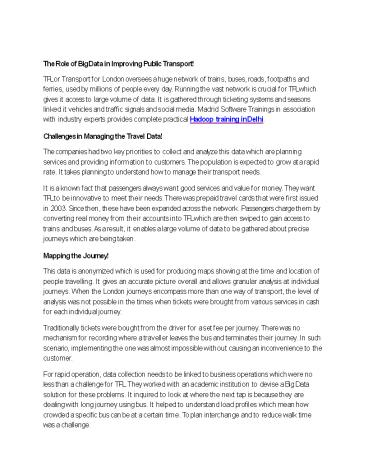Best Hadoop Training Institute - PowerPoint PPT Presentation
Title:
Best Hadoop Training Institute
Description:
The Role of Big Data in Improving Public Transport! TFL or Transport for London oversees a huge network of trains, buses, roads, footpaths and ferries, used by millions of people every day. Running the vast network is crucial for TFL which gives it access to large volume of data. It is gathered through ticketing systems and seasons linked it vehicles and traffic signals and social media. Madrid Software Trainings in association with industry experts provides complete practical Hadoop training in Delhi. – PowerPoint PPT presentation
Number of Views:3
Title: Best Hadoop Training Institute
1
The Role of Big Data in Improving Public
Transport! TFL or Transport for London oversees a
huge network of trains, buses, roads, footpaths
and ferries, used by millions of people every
day. Running the vast network is crucial for TFL
which gives it access to large volume of data.
It is gathered through ticketing systems and
seasons linked it vehicles and traffic signals
and social media. Madrid Software Trainings in
association with industry experts provides
complete practical Hadoop training in
Delhi. Challenges in Managing the Travel
Data! The companies had two key priorities to
collect and analyze this data which are planning
services and providing information to customers.
The population is expected to grow at a rapid
rate. It takes planning to understand how to
manage their transport needs. It is a known fact
that passengers always want good services and
value for money. They want TFL to be innovative
to meet their needs. There was prepaid travel
cards that were first issued in 2003. Since
then, these have been expanded across the
network. Passengers charge them by converting
real money from their accounts into TFL which are
then swiped to gain access to trains and buses.
As a result, it enables a large volume of data to
be gathered about precise journeys which are
being taken. Mapping the Journey! This data is
anonymized which is used for producing maps
showing at the time and location of people
travelling. It gives an accurate picture overall
and allows granular analysis at individual
journeys. When the London journeys encompass more
than one way of transport, the level of analysis
was not possible in the times when tickets were
brought from various services in cash for each
individual journey. Traditionally tickets were
bought from the driver for a set fee per journey.
There was no mechanism for recording where a
traveller leaves the bus and terminates their
journey. In such scenario, implementing the one
was almost impossible without causing an
inconvenience to the customer. For rapid
operation, data collection needs to be linked to
business operations which were no less than a
challenge for TFL. They worked with an academic
institution to devise a Big Data solution for
these problems. It inquired to look at where the
next tap is because they are dealing with long
journey using bus. It helped to understand load
profiles which mean how crowded a specific bus
can be at a certain time. To plan interchange and
to reduce walk time was a challenge.
2
Big Data analysis helped TLF to respond in an
agile manner as and when disruption occurs. Then
it was able to work out half of the journeys. The
other half included crossing a nearby bridge at
the half-way point of the journey. To serve their
needs, they set up a transport interchange and
enhance bus service on various alternate routes.
The company was able to quantify people by using
Big Data. Personalizing the News by Using
Technology! Travel data is also used for
identifying customers who take specific routes
regularly and send tailored updates to them. If
a customer uses a specific station frequently,
the information is included about service
changes at the station in their updates. It is
understood that people are hit by a lot of data
nowadays, so there is strong focus on sending
only relevant data. The information from the back
office systems is used for processing the
contactless payments. TFL also offers its data
through open APIs which is for use by 3rd party
app developers. It means that customized
solutions can also be developed for user groups.
The system is currently run by various Microsoft
and Oracle platforms. The organization is now
looking into adopting Hadoop and various other
open source solutions to overcome the increasing
demands of data. But hadoop seems to be a great
choice to cope up with growing data demands in
future. Plans for the future also encompass
increasing the capacity for real-time analytics
and work on integrating a wide range of data
sources to plan beter and inform customers. Big
Data has amazingly played a big part in
re-energizing the transport network of London. It
is evident that it has been implemented smartly
as well. Big Data is indeed interesting but
sometimes you require finding a business case.
Managing such a huge network of transport would
have been impossible for TFL without hadoop.
Therefore, it clearly reflects the power of big
data which is nowadays helping leaders to
overcome challenges of maning huge volume of
data. For more details please visit -
https//www.madridsoftwaretrainings.com/hadoop.php































